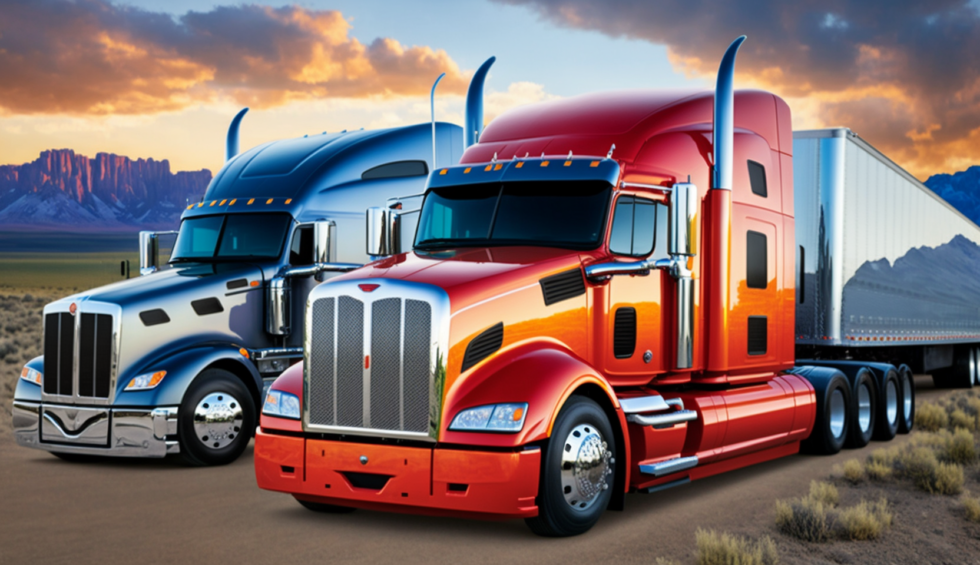Expert Truck Buying Guide: Everything You Need to Know Before Buying Your Next Truck


Trucks are versatile vehicles that can serve various purposes, from hauling heavy loads to off-road adventures. However, with so many options and features available in the market, choosing the right truck for your needs and budget can be overwhelming. In this expert truck buying guide, we’ll cover everything you need to know before buying your next truck, including assessing your needs and budget, choosing the right truck type and size, considering engine and transmission options, exploring available features and options, researching and comparing brands and models, negotiating and finalizing your purchase, and maintaining your truck for long-term reliability and value.
Assess Your Needs and Budget
Before you start shopping for a truck, you need to determine your needs and budget. Consider how you’ll use your truck, whether it’s for work, play, or a combination of both. This will help you determine the features and options you’ll need, such as towing and payload capacity, bed size, cab configuration, and off-road capabilities. Additionally, calculate your budget, including financing and insurance costs, to ensure you can afford the truck you want without breaking the bank.
Determine Your Truck’s Purpose and Usage
One of the most important considerations when buying a truck is determining its purpose and usage. Are you using it for work or play? Do you need it to haul heavy loads or navigate rugged terrain? The answers to these questions will help you choose the right truck type and size for your needs.
Calculate Your Budget, Including Financing and Insurance Costs
Once you’ve determined your needs, calculate your budget to ensure you can afford the truck you want. Consider financing options, including down payment, interest rates, and loan terms. Additionally, factor in insurance costs, including liability, collision, and comprehensive coverage, to determine the overall cost of ownership.
Choose the Right Truck Type and Size
Trucks come in various sizes and types, including full-size, mid-size, and compact trucks. Full-size trucks offer the most towing and payload capacity, while mid-size and compact trucks are more maneuverable and fuel-efficient. Additionally, consider your towing and payload requirements to ensure you choose a truck with the right capabilities.
Here’s a comparison table for choosing the right truck type and size:
| Truck Type and Size | Pros | Cons |
| Full-Size Trucks | Offer the most towing and payload capacity | Less fuel-efficient and challenging to maneuver in tight spaces |
| Mid-Size Trucks | Good balance between towing capacity and maneuverability | Smaller payload capacity than full-size trucks |
| Compact Trucks | Most fuel-efficient and easiest to maneuver in tight spaces | Lowest towing and payload capacity |
It’s also essential to consider your towing and payload requirements to ensure you choose a truck with the right capabilities. Make sure the truck you choose can handle the weight of your trailer or equipment. Additionally, keep in mind that trucks come in various types, including pickup trucks, heavy-duty trucks, and commercial trucks. Pickups are the most common type and come in full-size, mid-size, and compact options. Heavy-duty and commercial trucks are generally larger and used for commercial purposes.
Here are some key points to keep in mind:
- Types of Trucks: Trucks come in various types, including pickup trucks, heavy-duty trucks, and commercial trucks. Pickups are the most common type and come in full-size, mid-size, and compact options. Heavy-duty and commercial trucks are generally larger and used for commercial purposes.
- Full-Size Trucks: Full-size trucks are the largest option and offer the most towing and payload capacity. They’re ideal for heavy-duty tasks, such as hauling large trailers or equipment. However, they’re also less fuel-efficient and can be more challenging to maneuver in tight spaces.
- Mid-Size Trucks: Mid-size trucks offer a good balance between towing capacity and maneuverability. They’re smaller than full-size trucks but still have a decent payload capacity. They’re a good option if you need a truck for daily use but also want the ability to tow a small trailer.
- Compact Trucks: Compact trucks are the smallest option and are the most fuel-efficient. They have the lowest towing and payload capacity, but they’re also the easiest to maneuver in tight spaces. They’re a good option if you don’t need to tow heavy loads and want a truck that’s easy to drive and park.
- Towing and Payload Requirements: When choosing a truck, consider your towing and payload requirements. Towing capacity refers to the weight a truck can tow, while payload capacity refers to the weight it can carry in the bed. Make sure the truck you choose can handle the weight of your trailer or equipment.
Consider Engine and Transmission Options
Trucks come with different engine and transmission options, including gasoline and diesel engines and manual and automatic transmissions. Gasoline engines are typically more affordable and fuel-efficient, while diesel engines offer more power and towing capacity. Additionally, consider whether you prefer a manual or automatic transmission for your driving style and needs.
With so many choices available, it can be overwhelming to figure out which is the best fit for your needs. In this article, we’ll break down the differences between gasoline and diesel engines and help you choose between manual and automatic transmissions.
Gasoline vs. Diesel Engines:
One of the first decisions you’ll need to make is whether to go for a gasoline or diesel engine. Here are some key differences to consider:
- Cost: Gasoline engines are generally less expensive than diesel engines.
- Fuel Efficiency: Gasoline engines tend to be more fuel-efficient than diesel engines, but this can vary depending on the specific model and driving conditions.
- Power: Diesel engines offer more power and torque than gasoline engines, making them a good choice if you need to tow heavy loads or do a lot of off-road driving.
- Maintenance: Diesel engines tend to be more durable and require less maintenance, but repairs can be more expensive when something does go wrong.
Manual vs. Automatic Transmissions:
The next decision to make is whether you prefer a manual or automatic transmission. Here are some things to consider:
- Control: Manual transmissions give you more control over your vehicle and can be more fun to drive, but they require more skill to operate effectively.
- Convenience: Automatic transmissions are easier to use and are a better choice if you spend a lot of time driving in heavy traffic.
- Fuel Efficiency: Manual transmissions are generally more fuel-efficient than automatics, but this can vary depending on the specific model and driving conditions.
- Cost: Manual transmissions are usually less expensive than automatics, both in terms of the initial purchase price and ongoing maintenance costs.
Here is a table summarizing the differences between gasoline and diesel engines and manual and automatic transmissions:
| Gasoline Engine | Diesel Engine | Manual Transmission | Automatic Transmission | |
| Cost | Less expensive | More expensive | Less expensive | More expensive |
| Fuel Efficiency | More fuel-efficient | Less fuel-efficient | More fuel-efficient (generally) | Less fuel-efficient (generally) |
| Power | Less power and torque | More power and torque | More control | Less control |
| Maintenance | Require more maintenance | Require less maintenance | Less expensive to maintain | More expensive to maintain |
| Convenience | Easier to use | Not as easy to use | More difficult to use in heavy traffic | Easier to use in heavy traffic |
Explore Available Features and Options
Trucks come with various features and options, including safety features, comfort and convenience features, and technology. When shopping for a truck, review safety features and ratings, such as airbags, anti-lock brakes, and stability control, to ensure you choose a safe vehicle. Additionally, consider comfort and convenience features, such as air conditioning, power windows and locks, and infotainment systems, to enhance your driving experience.
Here are some key factors to consider:
Available Features and Options
- Engine size and power
- Transmission type (manual or automatic)
- Drivetrain (2-wheel drive or 4-wheel drive)
- Towing capacity
- Payload capacity
- Bed length and width
- Cab size (regular, extended, or crew)
- Interior and exterior color options
- Wheel and tire packages
Safety Features and Ratings
Safety should always be a top priority when shopping for any vehicle, and trucks are no exception. Some key safety features to look for include:
- Airbags (front, side, and curtain)
- Anti-lock brakes (ABS)
- Electronic stability control (ESC)
- Blind spot monitoring
- Rearview camera
- Parking sensors
- Forward collision warning
- Automatic emergency braking
- Lane departure warning and lane-keeping assist
You should also review safety ratings from reputable sources, such as the National Highway Traffic Safety Administration (NHTSA) and the Insurance Institute for Highway Safety (IIHS), to see how a particular truck performs in crash tests and other safety assessments.
Look at Comfort and Convenience Features
While safety is crucial, you’ll also want to consider the comfort and convenience features that can make your driving experience more enjoyable. Some things to look for include:
- Air conditioning
- Power windows and locks
- Heated and ventilated seats
- Leather upholstery
- Keyless entry and ignition
- Infotainment system with touchscreen display
- Smartphone integration (Apple CarPlay and Android Auto)
- Navigation system
- Premium audio system
- Sunroof or moonroof
By considering all of these factors and doing your research, you’ll be able to find the truck that meets your needs and exceeds your expectations.
Research and Compare Brands and Models
Once you’ve determined your needs and budget, researched available options, and explored features and options, it’s time to research and compare brands and models. Read expert reviews and ratings, check owner reviews and reliability data, and compare prices and features to find the right truck for your needs.
Here’s a table summarizing the steps to follow when researching and comparing trucks:
| Step | Description |
| 1. | Determine your needs and budget. Consider factors such as towing capacity, payload capacity, fuel efficiency, and overall size. |
| 2. | Research available options using sources such as consumer reports, Kelley Blue Book, Car and Driver, Edmunds, and Motor Trend. |
| 3. | Read expert reviews and ratings from reputable sources such as Consumer Reports, Car and Driver, and Motor Trend. |
| 4. | Check owner reviews on sites like Edmunds and Costco Auto and look up reliability data from sources like J.D. Power and Consumer Reports. |
| 5. | Compare prices and features, taking into account factors such as trim levels, options packages, and warranties. |
Here are some steps to follow when researching and comparing trucks:
- Determine your needs and budget: Before you start researching specific trucks, you should first determine what you need the truck for and how much you’re willing to spend. Consider factors such as towing capacity, payload capacity, fuel efficiency, and overall size.
- Research available options: Once you know what you’re looking for in a truck, you can start researching different brands and models that meet your criteria. Use sources such as consumer reports, Kelley Blue Book, Car and Driver, Edmunds, and Motor Trend to gather information on different trucks.
- Read expert reviews and ratings: Expert reviews can provide valuable insight into the performance, reliability, and overall quality of different trucks. Look for reviews from reputable sources such as Consumer Reports, Car and Driver, and Motor Trend to get an unbiased assessment of different models.
- Check owner reviews and reliability data: Owner reviews can also be helpful in determining how well a truck performs in the real world. Check sites like Edmunds and Costco Auto to see what real owners have to say about the trucks you’re considering. You can also look up reliability data from sources like J.D. Power and Consumer Reports to see how different brands and models compare.
- Compare prices and features: Once you’ve narrowed down your options, compare prices and features to find the best value for your money. Consider factors such as trim levels, options packages, and warranties to ensure that you’re getting the most for your money.
Negotiate and Finalize Your Purchase
Once you’ve found the right truck, it’s time to negotiate and finalize your purchase. Decide whether to buy or lease and know how to negotiate the best price and financing terms. Additionally, consider any incentives or discounts available, such as cashback offers or trade-in value.
Now, it’s time to negotiate and finalize your purchase. Here are some tips to consider:
- Decide Whether to Buy or Lease: This decision depends on your personal circumstances, such as how long you plan on keeping the truck and your financial situation. Leasing may offer lower monthly payments and the ability to upgrade to a new truck every few years, but you won’t own the vehicle at the end of the lease.
- Know How to Negotiate the Best Price and Financing Terms: Do your research beforehand and know the fair market value of the truck. Negotiate the price of the truck before discussing financing terms. If financing, get pre-approved for a loan from your bank or credit union before going to the dealership. Be willing to walk away if the dealership won’t meet your price or financing terms.
- Consider Any Incentives or Discounts Available: Look for any cashback offers or trade-in value that can be applied to your purchase. Some dealerships may offer discounts for military personnel, first responders, or college graduates.
- Check the Truck’s History: Ask for a vehicle history report to check for any accidents or damage. You can also have a trusted mechanic inspect the truck before purchasing.
- Read and Understand the Contract: Before signing any contracts, read and understand all terms and conditions. If you have any questions, ask the dealership to explain them to you.
By following these tips, you’ll be well-prepared to negotiate and finalize your purchase of a truck. Good luck and happy truck shopping!
FAQ
When choosing the size of your truck, consider your needs in terms of cargo and towing capacity, as well as the size of your garage or parking space. Full-size trucks generally have the highest towing and payload capacities, while mid-size and compact trucks may be easier to maneuver in tight spaces.
This depends on your specific needs and budget. Gasoline engines are generally less expensive and more widely available, but diesel engines offer better fuel efficiency and towing power for heavy loads. Keep in mind that diesel engines may require more expensive maintenance and repairs.
Look for trucks with advanced safety features such as backup cameras, blind spot monitoring, lane departure warning, and automatic emergency braking. Also, consider the truck’s crash test ratings from organizations such as the National Highway Traffic Safety Administration (NHTSA) and the Insurance Institute for Highway Safety (IIHS).
This depends on your budget and long-term plans. Leasing a truck may be a good option if you want to drive a new truck every few years and have lower monthly payments. However, buying a truck may be more cost-effective in the long run and give you more flexibility in terms of customization and resale value.
Follow the manufacturer’s recommended maintenance schedule, which typically includes regular oil changes, tire rotations, and inspections. Additionally, perform any necessary DIY maintenance tasks and repairs as soon as possible to prevent further damage and ensure long-term reliability.



